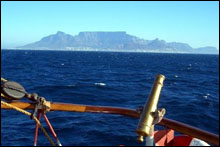Expansion into the Western Cape
|
Following consultations with relevant stakeholders, the SAEON Node for
marine-offshore systems is to be named the SAEON Egagasini
Node.
Loosely translated, egagasini means “a place of waves” in Zulu, thus adding a uniquely South African flavour to the node. The name is also in line with SAEON’s naming policy which uses SAEON as a prefix to an appropriate term from an indigenous language.
The first node to be established, the SAEON Ndlovu Node, was named after the elephant as a key driver in savanna systems. Ndlovu means elephant in Zulu. The second node, SAEON Elwandle Node, means “coast or sea” in Xhosa, and “at or on the sea” in Zulu, which reflects the coastal-marine environment in which the Node operates.
The SAEON Egagasini Node will be formally launched by the Minister of Science and Technology, Mosibudi Mangena, at a function on 29 November. As part of the day’s programme, MCM’s research vessel, the Ellen Khuzwayo will take a number of key stakeholders out of Cape Town harbour to demonstrate the use of offshore marine research equipment.
SAEON’s Egagasini Node is hosted by the Department of Environmental Affairs and Tourism’s branch Marine and Coastal Management (MCM) in Cape Town. Several programmes driven by MCM are set to become important data providers to SAEON’s Egagasini Node.
Developing a set of marine-offshore observation platforms
With the high costs associated with marine-offshore observations, Node Manager Dr Juliet Hermes anticipates that there will be considerable interaction between Egagasini Node staff and Node partners.
For this purpose discussions are ongoing between Juliet and some of the key stakeholders in large projects which are either in place or being planned. These include the Agulhas-Somali current Large Marine Ecosystem (ASCLME) and African Coelacanth Environment Programme (ACEP).
Discussions between Juliet and Dr Angus Paterson, Manager of the SAEON Elwandle Node have been ongoing with a view to developing an offshore component to the Elwandle Node’s Algoa Bay monitoring project. A meeting is planned for early next year when a key player, Professor Johann Lutjeharms of the Department of Oceanography at the University of Cape Town, will be back in the country. A great deal of interaction is likely between the Elwandle and Egagasini nodes and the ASCLME in terms of monitoring and data archiving.
Securing, integrating and disseminating long-term datasets
Juliet attended a number of meetings with relevant stakeholders where she was given the opportunity to present SAEON’s objectives and to investigate the various stakeholder needs in terms of data products and dissemination.
A particularly informative meeting between Juliet, SAEON’s Information Manager Avinash Chuntharpursat, the Southern African Data Centre for Oceanography (SADCO) and the CSIR highlighted some possible routes forward, including the need to have a focus on interoperability.
At this stage it is vital for SAEON and other programmes to use shared tools of dissemination architecture. Juliet proposes that a workshop be held to define value-adding end products as well as operational products. She also intends to approach the Benguela Current Large Marine Ecosystem Project (BCLME) to discuss the use of their data base.
Juliet represented SAEON at a SANAP conference and workshop during which the need for an extensive Southern Ocean and Antarctica and Islands data base was highlighted.
Her presentation elicited a positive response from many of the SANAP students with a need to obtain interdisciplinary data in the region. The SAEON nodes for coastal-marine and marine-offshore systems intend to fill this gap, and it is vital to have further high-level discussions with SANAP in the near future.
Juliet also attended the WIOMSA (Western Indian Ocean Marine Science Association) conference in Durban. This conference allowed plenty of opportunities to network with relevant stakeholders and to learn more about the science and observational programmes taking place in the Western Indian Ocean.
Juliet gave a poster presentation at both conferences, which elicited favourable comments from the audience. Both conferences highlighted the need for good long-term data sets across a broad array of disciplines. There are a number of disjointed efforts in place for data storage and the overall opinion was that these need to be linked and that the situation needs to be clarified to the person with the data as well as the end user. It is envisaged that SAEON will play a key role in brokering this interaction.
Node Liaison Committee
Juliet attended the Elwandle Node Liaison Committee meeting which proved to be useful and informative. Nine names have been put forward for the Egagasini Node Liaison Committee.
Appointment of staff
The recruitment advertisements for Node staff met with an overwhelming response. The applications have been narrowed down to a shortlist and interviews are scheduled for the last week of November.
Archiving, digitising and recovering data
Juliet met with Prof William Froneman, Chair of the Southern Ocean Group at Rhodes University. There is a large amount of valuable non-digitised data available on the Southern Ocean and Juliet is preparing to have these data sets digitised in conjunction with the Elwandle Node’s data manager, Dr Kim Bernard.
Juliet has also been approached by Rob Crawford of MCM to digitise and archive a large collection of photographs.












